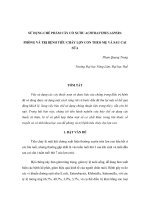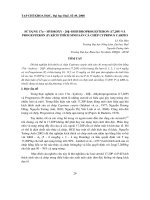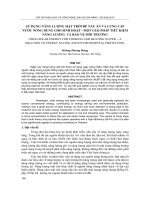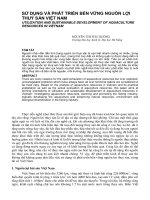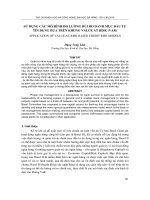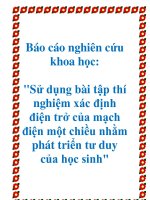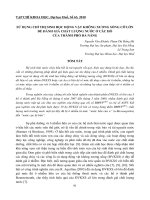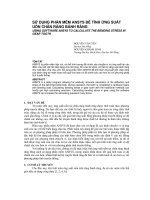Báo cáo nghiên cứu khoa học: "Sử dụng chương trình giảng dạy khối: một cách tiếp cận mới để cải thiện HIV và hỗ trợ đào tạo bệnh nhân Hải Phòng - Việt Nam" pptx
Bạn đang xem bản rút gọn của tài liệu. Xem và tải ngay bản đầy đủ của tài liệu tại đây (103.12 KB, 19 trang )
225
JOURNAL OF SCIENCE, Hue University, N
0
61, 2010
USING BLOCK CURRICULA: A NEW APPROACH TO IMPROVE HIV AND
AIDS PRE-SERVICE TRAINING IN HAI PHONG – VIET NAM
Ngo Van Huu, Pham Xuan Truong,
Pathfinder International Viet Nam
ABBREVIATIONS
HP Hai Phong
MC Medical College
MU Medical University
HIV/AIDS
Human Immunodeficiency Virus /Acquired immune deficiency
syndrome or acquired immunodeficiency syndrome
SOW Scope of Work
KAS Knowledge, Attitudes and Skills
PI Pathfinder International
SMS Secondary Medical School
SBIRT Screening, assessment, brief intervention, referral and treatment.
MOH Ministry of Health.
MCQ Multiple Choice Question
TU Technical Update
NGO Non-Government Organization
VCT Voluntary Counselling and Testing
IUD Intravenous Drug User
PAC Provincial AIDS Control Committee
RH Reproductive Health
PLWHA People Living With HIV/AIDS
226
SUMMARY
Introduction: Hai Phong has the highest HIV prevalence rates in Viet Nam. Most of
newly infected HIV cases in Viet Nam are IDUs. Currently curricula for medical and nursing
students are primarily theory-based, taught in a highly fragmented fashion and have limited
HIV/AIDS content. As a result, graduated students face difficulty in responding to the needs of
HIV-related services in general health settings. Methods: Since 2007, Pathfinder
International/Viet Nam supported the development and implementation of comprehensive, skills-
based curricula for HIV/AIDS care and treatment services at Hai Phong Medical University
(MU) and Medical College (MC). Technical assistance includes development of HIV/AIDS
curricula, technical updates, and establishment of and strengthen practicum sites at teaching
hospitals and within the community. Results: Three- and four-week rotations were designed and
used in both Hai Phong MU and MC. Feedback received from nursing and medical students in
the 2008-09 and from teachers and preceptors was used to improve curricula. To date, 384
medical and 659 nursing students have been taught newly revised HIV/AIDS curricula. Scores
analysis showed that knowledge levels of students improved significantly. From 53.5% to 89%
in general HIV/AIDS, from 32.5% to 81% in drug abuse among nursing students at baseline and
end-rotation assessment are examples. Conclusions: (1) comprehensive skills-based curricula
allow students to practice HIV/AIDS care, treatment, and counseling skills, work directly with,
understand the issues and counseling needs of IDUs and PLWHA and therefore their knowledge,
attitude and skills improved, (2) remaining challenges include time and coordination limitations
of instructors to train on HIV/AIDS related clinical skills.
Key words: Medical Education, HIV/AIDS, Curriculum, Pre-service training, Medical
students, Nursing students
1. Introduction
Vietnam is among the countries that have the fastest growing HIV pandemics in
the world. Figures for Vietnam show HIV infection rates of more than 20 percent among
injecting drug users in most provinces. Disturbingly, the high rates of HIV infection
among sex workers previously noted in the south of the country have now been found in
the north (15 percent of sex workers in Hanoi are estimated to be HIV-positive). HIV
cases have been reported in all 64 provinces, with the highest infection cases in Ho Chi
Minh, Ha Noi, Hai Phong, Son La and Thai Nguyen. Among other reasons, intravenous
drug use continues to be the major contributor to the rapid spread of the disease. All
health facilities, at the grassroots, provincial and central levels, have encountered
HIV/AIDS patients, and in the future, health facilities will receive a growing number of
HIV/AIDS cases.
Hai Phong is one of the biggest cities in Vietnam and has one of the highest HIV
infection rates in the country. According to the statistics reported by the Hai Phong
227
Department of Health, as of July 20, 2007, there are 8,236 persons living with
HIV/AIDS, among whom 3,829 have progressed to AIDS (comprised 46.82% of HIV
positive cases). There have been 2,579 deaths (69.83% of AIDS patients). All 100% of
communes reported having people living with HIV/AIDS in their localities. There is
growing concern in Hai Phong of a generalized epidemic, given the rising proportion of
HIV positive women (representing 10.5% of 100 cases in 2000 and 34.2% in 2006/7).
Injecting Drug Users (IDUs) represent 61% of all HIV positive individuals in Hai
Phong. HIV infection among sex workers is highly correlated with injecting drug use.
Among street-based sex workers in Hai Phong, only 3% of sex workers without a
history of injection are HIV positive compared to 55% of those who have ever injected.
To fight the epidemic, a concerted and coordinated effort is required of all
sectors, including government and non-governmental agencies, mass organisations,
academic and research institutions, and the society as a whole. The training and
education sector, especially medical education and training institutions, will play a key
role through the contribution of trained/graduated doctors, nurses and midwives,
pharmacists, and other concerned staff.
Building on its extensive experience with medical education reform in Viet Nam,
Pathfinder International has implemented a project entitled HIV Prevention in Pre-
service Training: Building a Comprehensive Curriculum at Hai Phong Medical
University and Medical College with Potential to Scale up to Eight Medical Faculties in
Vietnam. The objective of this project has been to provide high quality, technically
sound, skills-oriented HIV prevention education, with a focus on substance abuse
prevention, relapse prevention and addictions counseling in Hai Phong Medical
University and Secondary Medical School. The project is expected to have two
Intermediate Results, including the production of an HIV prevention education
curriculum for Medical University and Secondary Medical School, and a supportive
policy environment for curriculum uptake on a wider scale.
The evaluation was conducted in both HP MU and MC, after two years of
project implementation with the following objectives:
To evaluate the KAS of faculty members and preceptors (health staff
involved in teaching students) of the two schools who were involved in
teaching the HIV/AIDS block curricula in comparison with the findings of
the baseline survey, and in comparison with required HIV KAS.
To evaluate the KAS of students who recently completed the HIV/AIDS
blocks in both Hai Phong MC and MU, in comparison with related findings
of baseline survey, and in comparison with required HIV KAS.
To describe the current curricula and teaching/learning materials used for
HIV/AIDS block teaching.
228
To evaluate the roles of clinical and community field teaching sites to
provide an effective environment for HIV/AIDS teaching.
Comment on the sustainability of the project’s achievements in HP MU and MC
and the possibility to scale up the curricula to other medical schools in Vietnam.
2. Methods
2.1. Qualitative study
A number of qualitative research methods were utilized to maximize the rigor
and quality of information. The team conducted in-depth interviews with 31
stakeholders, one focus group discussion with eight nursing students and one focus
group discussion with eight medical students. The evaluation team also observed the
teaching/learning environment.
In-depth interview: 31 in depth interviews were conducted at the two schools
with senior managers and faculty. Preceptors and managers of practicum sites were
interviewed at their own institutes.
Focus group discussion: two focus group discussions were conducted, one with
eight medical students and one with another eight nursing students, who had studied or
had been studying HIV/AIDS prevention and substance abuse subjects.
Observation: the evaluation team directly observed the working and teaching
environment of all visited practical sites and classrooms to supplement information
from interviews and observed two MC teachers’ theory teaching in lecture halls.
Literature review: the following project documents were reviewed: teaching
plans, training materials, project documents, MU and MC reports of project
implementation activities, bulletins during the evaluation process and reports from PI on
this project.
2.2. Quantitative study
For the quantitative assessment, a self-administered questionnaire was used to
assess the knowledge and attitude of students and teachers participated in this survey.
All interviewed teachers who taught the HIV/AIDS curricula were asked to fill in the
questionnaires.
51 second year nursing students in the MC and 39 sixth year medical students in
the MU were selected randomly from the previous year’s class of students. This survey
was used to measure a change in the KAS of students, teachers and preceptors between
the results of the baseline survey and the end of the project. All teachers of the MU and
the MC who teach theory or/and practice in this topic and were available at the time of
the evaluation, were invited to participate in the evaluation. In total, there were six MC
teachers and five MU teachers.
229
3. Results
Table 1. Outputs summarized from each element of the project
Elements of project Outputs from HIV/AIDS prevention project
Curriculum
development
A list of required KAS for HIV/AIDS prevention was
developed for both medical and nursing students
Two HIV/AIDS curricula (including drug abuse) covering 25
lessons in 4 weeks for medical students and 11 lessons in 3
weeks for nursing students were finalized and published.
Curricula were approved and disseminated to all faculties,
submitted for approval from MOH
Technical updates
178 turns of faculty, teachers and preceptors of both schools
received technical updates and strengthening their teaching
capacity (on HIV/AIDS topic and teaching/learning methods).
Topics include:
+on drug and substance abuse,
+HIV prevention, communication strategies against stigma and
discrimination,
+adolescents and HIV, substance abuse amongst adolescents,
effective intervention when working with adolescents,
+screening techniques for alcohol and drug use, brief
intervention, and referral and treatment (SBIRT).
Field teaching sites
upgraded
Expand field teaching sites: 19 practicum sites for both schools.
9/12 selected field teaching sites for both schools have been
supported equipment for teaching and learning
23 preceptors have been updated with knowledge and skills
practiced at those sites
No. of students
studied HIV/AIDS
block
Year 2008-09: 123 medical students of MU, and 297 nursing
students of MC
Year 2009-2010: 259 medical students of MU, and 362
nursing students of MC (As of Mar 2010)
Ethic curriculum
development and
The ethics curriculum has been finalized and was first used in
school year 2008-2009.
230
teaching
Year 2008-09: 259 medical students learned ethics curriculum.
Year 2009-2010: 225 Y5 medical student have been taught with
this curriculum.
Other teaching
learning materials
Multiple methods are applied
In Hai Phong Medical University, there are 425 questions
totally developed.
Hai Phong MC has developed 175 question
3.1. Baseline Assessment and dissemination of the findings
In 2007, before the implementation of this project, a baseline assessment was
conducted to measure the existing situation of teaching and learning on HIV/AIDS
related topics. Key gaps that were identified, include:
Students of both schools were found to have very limited knowledge of
HIV/AIDS, especially related to drug abuse, addiction and relapse.
Almost all faculty members who taught HIV-related topics had participated
in HIV/AIDS training courses, but their knowledge and skills varied
considerably. Traditional teaching methods such as lecturing were the main
methods used by faculty members of both schools. Practice on counseling
skills was mainly through observation.
The HIV/AIDS curriculum of these institutions focused mainly on theory,
with little information about prevention and care related to drug abuse,
relapse prevention or counseling skills. HIV/AIDS topics were taught across
different departments, but no close linkage existed to allow for a
comprehensive program. Students had a very short practicum rotation in the
infectious disease department of the Viet Tiep Hospital, where they were
exposed to the practice of care and treatment for people living with
HIV/AIDS.
Practicum sites were not diversified and had limited facilities. The staff
typically has no up to date technical knowledge.
3.2. A new teaching module developed
A list of essential KAS in HIV/AIDS, drug abuse, addiction and relapse was
developed. Based on this list, the faculty members of the two schools developed
comprehensive HIV/AIDS prevention curricula (including drug abuse) covering 25
lessons for medical students and 11 lessons for nursing students. Both schools agreed to
teach the HIV/AIDS curriculum as a block curriculum, devoting 4 weeks at HP MU and
3 weeks at HP MC. Block teaching allows for a more logical construction of curricula
231
and a more intense learning experience. The block curriculum also includes clinical
practicum time in hospitals and time spent in the community. Up until the evaluation in
early 2010, the curricula were taught twice, to total of 969 students who received
training in this new topic.
The work overloading of teachers was mentioned as a challenge by
interviewees; however, the teachers have recognized the benefit of being involved in the
project activities. For example
“We have to work hard to prepare our teaching/learning materials, but this is a
good opportunity for us to be retrained in active teaching methods and improve our
skills to prepare teaching and learning materials as well as active teaching skills” MC
Teacher.
The strong commitment of the leaders of both schools toward the training
program is an essential element for the success of each project. In addition, the
involvement of the training departments in arranging the modules contributed to the
project’s success.
The content of the module was considered by teachers and preceptors of both
schools to be appropriate and necessary for medical and secondary nursing students.
The structure of the modules provided comprehensive and systematic learning in
HIV/AIDS prevention and substance abuse. However, teachers and training managers of
HP MU recognized that there was a minor overlap of this module with infectious and
Tuberculosis subjects in some topics. This problem did not occur in the MC because
related topics were removed from the teaching plans.
“This module provides comprehensive contents on HIV/AIDS, which is useful
preparation for students for their future careers.” – MU Teacher
“I like this module. It includes all the knowledge and skills from virology to
prevention to treatment. It is easy for us to understand and apply in our practicum.” –
MU student
The effectiveness of this module was proved by the test results on KAS of
HIV/AIDS topics before and after the intervention. Students attained a significantly
higher grade compared to the same tests done before the intervention (see “Impact on
Students” for details).
3.3. Establishing new practicum sites
The use of block teaching in the HIV/AIDS module is new to the two schools.
The module is quite different from other subjects, which focus only on hospital or
community practicum sites, because this module includes theory and practical lessons in
hospitals and at community sites. Practical lessons in hospitals were organized in the
two current practical hospitals of schools – Infectious Department of Viet Tiep General
232
Hospital and Hai Phong Tuberculosis. Some criteria used for selecting the hospitals to
become a clinical practicing site include not being a great distance from the MU, having
enough patients for teaching/learning, meeting the minimum equipment requirements
and the willingness of staff to receive and train students.
At the community level, the two schools have communicated and jointly
established some new practicum sites in HIV/AIDS clinics, and health centers. There
are 19 practicum sites for both schools. These sites provided necessary skills for
students in this module such as counseling before and after informing laboratory test
results, communication with HIV/AIDS patients and drug users, household visits and so
on.
3.4. The technical/teaching capacity of teachers had been improved through
technical updates on HIV/AIDS topics and teaching methods
3.4.1 Increasing and updating knowledge of teachers
A series of technical updates related to HIV/AIDS and active teaching
methodologies were organized for 178 faculty members who were involved in teaching
the HIV/AIDS block at both schools. The topics that were covered included: substance
use and abuse, HIV prevention and communication strategies to address stigma and
discrimination, understanding of adolescents with HIV and adolescent substance use,
effective interventions in working with adolescents; and principles and techniques of
alcohol and substance abuse screening, brief intervention, referral, and treatment
(SBIRT), as well as critical skills to work with students such as coaching, providing
feedback, supervision skills and skills to support students during their learning at
community practicum sites.
Results from self-administered questionnaires for teachers’ knowledge on
HIV/AIDS prevention and substance abuse revealed that after two years of project
implementation, the teachers’ knowledge has increased significantly.
At the beginning of project, the teachers’ knowledge on HIV/AIDS prevention
and counseling was low; few of them could correctly answer topic-related questions, but
their knowledge after the intervention increased, particularly related to counseling and
HIV/AIDS prevention.
Table 2. Changes of participating teachers’ knowledge on HIV/AIDS
Baseline
survey
Final
Evaluation
(n=12) (n=11)
What type of cell in the body does HIV attach to?
Correct answer
6
11
233
Incorrect/ NA 6 0
What is the lifecycle of HIV?
Correct answer
Incorrect/ NA
4
8
10
1
What are the risk factors of HIV?
Correct answer
Incorrect/ NA
6
6
9
2
3.4.2. Improve teachers’ teaching skills
During the courses on active teaching methodologies, 41 teachers learned how
to teach HIV/AIDS prevention in an active way, making students the center of the
learning experience environment. Teachers were asked to prepare their presentations
and perform trial teaching. Thorough guidance by international consultants as well as
the PI group, together with comments from peers was said to help teachers apply new
teaching skills more effectively. None of the participating teachers reported difficulties
with teaching this module. However, the application of new theory teaching methods
was limited at the MU due to large numbers of medical students in each class.
Overall, the updates and training courses were highly appreciated by the teachers
involved. Junior teachers felt that they could gain significant knowledge and skills,
which were new to them, while more senior teachers felt that these courses brought new
and updated knowledge on HIV/AIDS prevention.
Table 3. Teachers’ self-assessment on their teaching capacity
Contents Baseline survey Post-intervention
HIV/AIDS teaching capacity (%)
Good 39.4 9.1 (1/11)
Very good 32.5 72.7 (8/11)
Excellent 9.8 18.1 (2/11)
Improvement in teaching methods (%)
Good 28.5 9.1 (1/11)
Very good 35.7 81.8 (9/11)
Excellent 3.6 9.1 (1/11)
A good example of improved teaching skills, reported by students in focus group
discussions, was the application of new technologies (power point presentations) with
234
good illustrated pictures, and of the seminars with real HIV/AIDS patients and drug-
addicted people. The students’ comments are in line with those of the evaluators who
observed class teaching. Two teachers of the MC were observed during their theory
teaching. They had well-prepared hand-outs and power point presentations. The lectures
were clear and easy to understand with time set aside for questions.
4.7
46.5
9.3
25.6
2.0
13.7
33.3
51.0
0.0 10.0 20.0 30.0 40.0 50.0 60.0
Poor
Good
Very Good
Excellent
%
Final Ev.
Baseline
Figure 1. Students’ feedback on HIV/AIDS teaching before and post-intervention of project in
HP MU & MC
3.4.3. Attitude towards teaching the HIV/AIDS module
One of the essential findings is that most teachers recognized the importance of
new module and thought that it was very necessary for medical and nursing students to
learn and prepare for their future career. They were enthusiastic to participate in
necessary activities to create and implement the new module. However, while teachers
of the MU recognized the benefit for their career, some teachers in the MC said that it
brought a greater burden of work for them as they had to prepare lessons and develop
training materials throughout the process.
“I enjoyed this project. We attended a lot of training courses and workshops… I
cannot remember names of all of them. We obtained the knowledge and skills in
teaching and coaching students, the teaching/leaning materials have been revised and
modified many times, it is time consuming but the documents’ quality becomes better
with every revision and modification” MC Teacher.
3.4.4. Coaching skills
With support from this project, both the MU and the MC expanded their
HIV/AIDS clinical teaching for their students to many field teaching sites in addition to
their teaching hospitals. These HIV/AIDS related teaching sites have received support
from different projects and therefore they have capable staff, some equipment and
sufficient client load for students to practice with.
The preceptors of these field teaching sites attended training workshops on
P<0.01
235
HIV/AIDS related knowledge and skills, either organized by the project or by other
HIV/AIDS projects/programs. The project provided a good platform for them to refresh
and enhance their knowledge and skills through working with the students. More
importantly, these preceptors have been trained on how to teach and coach students at
the practicum sites.
“It is interesting to give guidance to students in our center. I have no difficulty in
teaching since I had participated in a number of training courses on HIV/AIDS
counseling and presentations ” – Young female preceptor
Some preceptors had extensive experience on HIV/AIDS topics; they had even
worked as resources for other workshops. Leveraging them as resources for further
training courses for young teachers may be good strategy.
“I participated in teaching students for a number of years. In addition, I was
invited a few times to provide lectures in HIV/AIDS courses for health staff in Hai
Phong and other provinces under different projects ” – senior female preceptor
3.5. Impacts on students
3.5.1. Improved knowledge on HIV/AIDS prevention and substance abuse
In the evaluation, 90 students (51 nursing students and 39 medical students)
filled in the self-administered questionnaires. The results show that after receiving
training on HIV/AIDS, students’ knowledge on HIV/AIDS such as virology, risk factors,
reducing of risks and HIV prevention improved markedly.
(a) in the MC
0%
10%
20%
30%
40%
50%
60%
Poor Good Very good Excellence
Baseline
Final
(b) in the MU
0%
10%
20%
30%
40%
50%
Poor Good Very good Excellence
Baseline
Final
Figure 2. Students’ knowledge on HIV comparing the baseline survey and post-intervention
P<0.05
P<0.05
236
(a) in the MC
0%
10%
20%
30%
40%
50%
60%
Poor Good Very good Excellence
Baseline
Final
(b) in the MU
0%
10%
20%
30%
40%
50%
60%
70%
Poor Good Very good Excellence
Baseline
Final
Figure 3. Students’ knowledge on risk factors of HIV/AIDS comparing the baseline survey and
post-intervention
(a) in the MC
0%
10%
20%
30%
40%
50%
60%
70%
80%
Poor Good Very good Excellence
Baseline
Final
(b) in the MU
0%
20%
40%
60%
80%
100%
Poor Good Very good Excellence
Baseline
Final
Figure 4. Students’ knowledge on how to reduce risks of HIV/AIDS comparing the baseline survey
and post-intervention
(a) in the MC
0%
10%
20%
30%
40%
50%
60%
Poor Good Very good Excellence
Baseline
Final
(b) in the MU
0%
10%
20%
30%
40%
50%
Poor Good Very good Excellence
Baseline
Final
Figure 5. Students’ knowledge on general and HIV/AIDS counseling comparing the baseline survey
and post-intervention
P<0.05
P<0.05
P<0.05
P<0.05
P>0.05
P
>
0
.05
237
With regards to the change in students’ knowledge on HIV/AIDS, risk factors,
and reduction of HIV risk infection, the proportion of students with better results is
higher (significant difference of p<0.05) in the post-intervention group compared to the
baseline survey. The changing of students’ knowledge on counseling in general and
HIV/AIDS counseling specifically before and after project intervention activities was
not as significant as other topics even though the data showed a higher rate of ‘good’
and ‘excellent’ and lower rate of ‘poor’ knowledge levels.
3.5.2. Skills achieved in this module
In this evaluation the skills of the students were not measured directly. The
reason for this limitation was that it was not practical to make observations on students’
skills during the time of evaluation. However, an alternative approach was taken to
evaluate the students’ achieved skill by a self-reporting method.
Students reported that they had learned different kinds of counseling services,
including counseling for HIV/AIDS patients before and after blood tests and counseling
for addicted people, among others. These were new skills they had not studied or
practiced before and that not been included in the curriculum before. They recognized
that these skills were very useful and practical because they could use them to protect
themselves, to provide counseling to their family members, friends, and neighbors,
especially given that substance abuse and HIV/AIDS are very hot issues in every
community. They felt confident in their abilities to provide these counseling services
after completion of this module.
3.5.3. New attitude towards HIV/AIDS and addicted people
Discussions with students revealed that all of them thought this was a very
useful topic for their career. One positive aspect of this module, according to students, is
that it gave them the chance to communicate with HIV/AIDS patients and addicted
people. This communication happened both in theory classes, where addicts and
HIV/AIDS patients were invited to come and share their experiences, and at community
practicum sites. After completing the module, students report that they no longer fear or
discriminate against HIV/AIDS patients and addicted people.
“It is interesting to freely talk to HIV-infected and addicted people about their
problems in a community setting. We understand more about them, sympathize with
them and do not fear them as before.” – Medical student
Students were also happy with the course as they did not have to pay for the
training materials and lecturers’ presentations which had more pictures than other topics.
The success of this module is demonstrated not only by how much
knowledge the students gain on HIV/AIDS prevention and substance
abuse but more importantly in their improved skills and changing attitude.
238
Students now feel confident in their counseling skills, which they could
use to protect themselves and advise their family, friends, and neighbors.
Talking to HIV/AIDS and addicted people at community practicum sites
helped students gain a sympathetic view of these vulnerable groups and to
not discriminate against them.
Practice time in the hospital was not effective for medical students
because of the large number of medical students allocated to each practice
time leaving the students with significantly fewer opportunities for
practice.
3.6. Teaching plan and training materials
3.6.1. Teaching plan
Teaching plans were co-developed by the teachers, training managers,
international consultants and PI team. Overall, the teaching plans of the HIV/AIDS
prevention and substance abuse module in medical and nursing programs were
structured clearly with detailed and necessary information. The following information
can be found in the teaching plans of both schools:
Learning objectives;
Required reference materials for students
Teachers/faculty in charge
Procedures for dividing students into groups and practicum rotations
Timetable and venue for theory lessons
General objectives of practicum
Timetable for practicum in hospitals and at community practicum sites
Preceptors who would be in charge of each community practicum site
Knowledge and skills, including compulsory and optional skills to be
attained in each practical sites
Procedures for assessing students’ knowledge and skills and calculating their
final scores
As the teachers and coordination team mentioned, the plans were clear and easy
for them to implement because they played a main role in developing them.
3.6.2. Teaching materials
Two textbooks were compiled and prepared for medical and nursing students to
use, even though they were only in photocopy format and not printed yet. The teachers
239
acknowledged that these textbooks were very useful for them as they covered
comprehensive HIV/AIDS prevention and substance abuse topics and the textbooks’
contents were good and easy for students to understand.
The students had the same comments on the textbooks, which they found very
useful for them to learn with and later to use as reference material for their career. The
students also reported that the figures in the textbooks helped them to digest the content
more easily.
Some preceptors were invited to provide comments on the textbooks while they
were being written. They all agreed that these were good textbooks for students as they
provided up-to-date and adequate contents in an easy to understand writing style.
The process of compiling these textbooks was a systematic one. First, the two
schools discussed and agreed upon topics to teach to the medical and nursing students.
Teachers and training managers were then involved in compiling the textbooks with
technical support from PI. Drafts were then sent to experts and preceptors for review
and comments, and returned for revision. As well, feedback was provided at the end of
each time of block implementation by students and teachers who were involved in
teaching students. This feedback was then incorporated into revised versions.
As well as the textbooks, other documents developed included KAS in
HIV/AIDS prevention and substance abuse for medical students and nursing students
and lesson plans for all of the lectures. These documents were prepared well and played
important roles during the process of compiling the textbooks and lecturing.
Over the course of just two years, essential and necessary
materials were sufficiently developed to provide tools for implementing
the new module. These materials proved themselves to be good tools for
teaching and learning.
4. Discusion
4.1. Remaining Challenges
There were a number of challenges involved in implementing the project,
including time constraints in the curriculum, key staff members being overloaded and
busy with many jobs, increasing medical student enrolments, and budgetary constraints.
The schools have to follow a curriculum framework for medical and nursing
program issued by Ministry of Education and Training and Ministry of Health, the
subjects and timetable of which were quite inflexible. For example, the medical
program under this framework has 320 credits and they are all allocated to subjects of
schools’ departments. Arranging a new block in the existing program is not easy. The
medical university decided to allocate 3 weeks of community practice for this module in
240
the last year of the in medical program and therefore students don’t have any time to
practice other areas in community. Teaching hospitals being overcrowded by a large
number of students are another challenge. In the medical college, leaders of the school
decided to take out time for related lessons from other departments such as Obstetrics
and Gynaecology department and Paediatrics department for this new module. This way
seems more realistic. However, the current coordination role of the training department
should be shifted to one professional department soon to ensure the sustainability of the
module.
The first batch of medical students who studied the new module included more
than one hundred and there were no problems in dividing them in community practical
sites. However, due to the increasing number of students enrolled, the second batch
included around 250 and it is expected that next year there will be around 400 students.
If the number of practical sites is not expanded, then the number of students in each site
will increase significantly, obviously affecting the quality of practice and bringing
burden to the existing practical sites.
Teachers and faculty of the two schools were usually busy with an overload of
work or had some other “more interesting” things to do. This issue is related to the low
official payment for the teachers, and therefore they have to seek other jobs that bring
supplemental incomes. Some teachers at the medical college did not fully appreciate the
systematic working method of the project, which was time-consuming, and they said it
required too much of their time.
The medical college managers raised the conflict between increasing
payment/wages for teaching this module and the school’s fixed income overall. This
issue should be considered by the schools themselves to make sure implementation
could continue.
4.2. Sustainability
The sustainability of the project has been considered by the leaders of both
schools. Each school has its own context; however they both confirmed that they could
continue running the HIV/AIDS prevention and substance abuse module.
There are several external and internal elements that support the sustainability of
this module. First, HIV/AIDS is well recognized as a pandemic, which draws a
numerous attention of different organizations and countries. The number of people
infected with HIV continues to rise in most parts of the world, despite the
implementation of prevention strategies. Vietnam is not staying out of this situation;
therefore, accelerating the fresh training of HIV/AIDS in medical schools is needed.
Second, National Strategy on HIV/AIDS prevention issued in 2004 brought out the
needs of having HIV/AIDS training in medical program as well as training programs for
other health professionals.
241
Internally, the most important element for the sustainability is strong
commitment of leaders of two schools. Other elements include teaching capacity of
teachers in HIV/AIDS, the schools’ capacity in arranging practical sites for students,
availability of comprehensive training materials and very importantly what students
have shown to achieve after two years of the project.
However, in order to uphold this module in the two schools, the stakeholders of
the project should take into account the current challenges, especially how to organize
the module in the whole training program. The best solution is to extend the project for
another phase and continue the support for at least two years to solve the main existing
problems.
4.3. Possibility to scale up to other medical schools
There are some good reasons for this module to be scaled up in other medical
schools. They include the success that two schools have experiences in applying the
module in their training program, the capacity of their teachers, and the availability of a
number of products from this project that could be used in other schools. Another reason,
shown through what the students have taken this module have proven to achieve, is that
they could change their attitude towards HIV/AIDS patients as well as could learn
counselling skills.
Additionally, the attention of MOH in having HIV/AIDS training in medical
program as well as training programs for other health professionals indicated in
National Strategy on HIV/AIDS prevention issued in 2004 could be the good legal basis
for scaling up this module.
There was significant involvement of relevant stakeholders in this project
implementation. During the project life, whenever possible, stakeholders from other
medical universities/colleges have been invited to participate in training/workshops in
order to keep them informed and updated. This would help them not only by updating
their knowledge and skills but also preparing them for scaling up later on.
Nevertheless, before expanding to other schools, these two pilot schools and the
project implementers should work more on how to organize the module in the whole
training program.
5. Conclusion
The project objectives focused on one of the important health problems of health
care system in Vietnam.
Engagement of schools’ leaders, mangers and staff is an important factor for
ensuring the success and sustainability of the project.
The systematic design of the project ensures the objectives are achieved.
242
The two schools invited other resource people (preceptors), who provided their
professional expertise from their participation in other HIV/AIDS projects, to coach
students and expand their working capacities.
Community practicum sites, which were newly established by this project, could
be a good model for students to learn not only about HIV/AIDS specifically but also
proper communication skills with patients in general.
There were some challenges that need to be considered in order to maintain and
expand the results of the project.
This model can be expanded to other MU and MC/SMS
6. Recommendations
The HIV/AIDS module provided a good model for applying a new teaching
subject that generates a high learning demand. Based on major findings from this
evaluation, there are several recommendations for various stakeholders.
6.1. Ministerial and central levels
6.1.1. As stated in National Strategy on HIV/AIDS Prevention, HIV/AIDS will
be formally taught at health science institutions for their students by the year 2010.
Vietnam Administration of HIV/AIDS Control and Department of Science and Training
should work together on how HIV/AIDS related issues can be taught formally and
effectively at these medical training institutions.
6.1.2. The HIV/AIDS block curricula, implemented at both HP MU and MC
should be used to teach other medical and nursing students.
6.1.3. The HIV/AIDS curricula developed by the two institutions should be
approved as the standard curricula by the National Curriculum Committee after they
have been carefully reviewed and revised by experts.
6.2. Hai Phong MU and MC
6.2.1. The MU should work more on organizing the module in the whole
program curriculum, for example considering it as another specialty subject such as
tuberculosis, infectious diseases, and ophthalmology, etc. In this case, instead of having
all students study theory or practice at the same time, students can be divided in classes
and rotate studying theory and practice. The MU should establish the sustainable
coordination unit for this module soon.
6.2.2. The MC should also maintain this module along with other regular
subjects.
6.2.3. The number of community practicum sites should be expanded for the
MU to serve the increasing number of students in the future. In case it is difficult, the
243
school should find a way to organize the students to ensure that the same number of
students is at each site and that the number does not exceed the optimal levels.
6.2.4. Some overlapping topics of the curriculum for medical students, such as
infectious diseases and tuberculosis, could be removed and combined with the
HIV/AIDS module. This is also the suggestion made by the relevant
departments/faculties and coordination group. The two schools should review their
current curriculum and appropriately and logically rearrange the scheduling for related
subjects.
6.2.5. The schools should have regular activities or rewards to acknowledge
preceptors for their teaching students, in order to ensure their long-term enthusiasm.
Supervision and monitoring in field sites, including students’ feedback, should be
improved in order to have immediate adjustments at the practicum sites to ensure all
students can practice with good coaching by preceptors.
6.3. Other medical training institutions and other stakeholders
6.3.1. When HIV/AIDS is officially approved as a required specialty for pre-
service training, other medical universities and colleges should consider adapting the
curricula developed and used by these two schools after reviewing and adjusting them
for their individual needs and situations.
6.3.2. For effectiveness, the replication strategies should include updating
knowledge for teachers and preceptors, strengthening teaching methodologies,
developing teaching/learning materials, selecting and expanding clinical teaching sites,
etc as done in this project.
REFERENCES
1. Pathfinder International, Baseline Survey of HIV-ME project, 2007.
2. Pathfinder International, Project Document, HIV-ME project, 2007.
3. VAAC, HIV/AIDS situation in 2009 in Vietnam, report to government number
1991/BYT-AIDS, 06/4/2010.
4. VAAC, HIV/AIDS report in the first 6 month of 2009.
5. Vietnamese Government, HIV/AIDS control LAW
6. WHO: One death from AIDS every minute in Asia-Pacific, Press Release on HIV/AIDS,
April 26, 2006.
